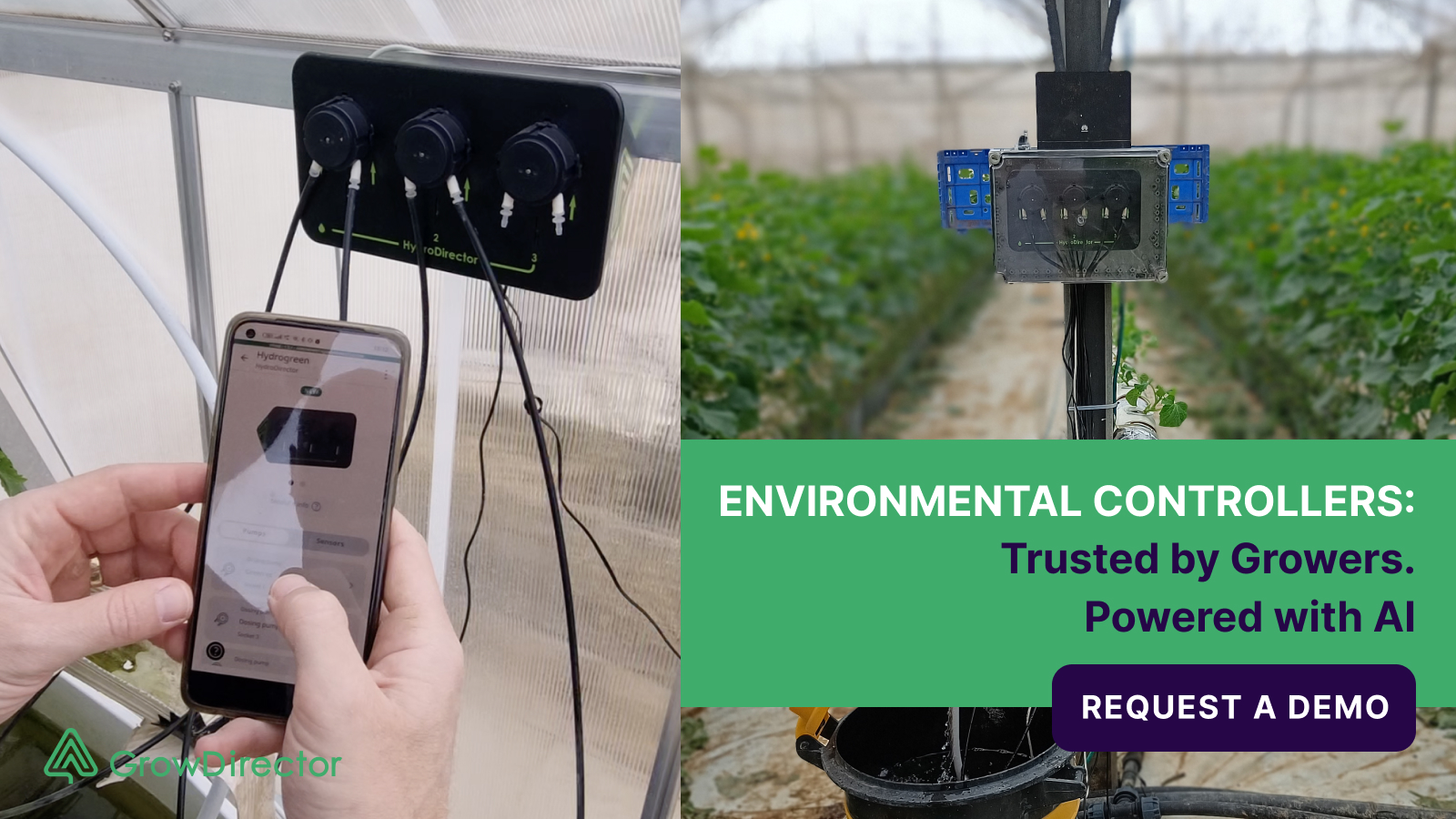
The Ultimate Crop Rotation Guide for Commercial Hydroponics Growers.
Controlled environment agriculture (CEA) offers immense potential for commercial growers. A crucial element for maximizing yields and profitability in CEA is strategic crop rotation and selection. This crop rotation guide, drawing on 14 years of hands-on experience in greenhouse and hydroponic systems, will equip you with the knowledge to optimize your operations.
What is Crop Rotation and Why Should You Care?
Crop rotation definition: It’s simply switching up the types of crops you grow in the same area over time. But in controlled environments, where we’re often dealing with hydroponics and limited space, it becomes your secret weapon for long-term success.
Why is crop rotation important? Think of it like this: your plants are hungry, but they don’t all crave the same food. Tomatoes are potassium fiends, while leafy greens gobble up nitrogen. Crop rotation ensures a balanced diet for your plants, preventing nutrient depletion and keeping those roots happy.
Plus, those pesky pests and diseases? They love a good monoculture buffet. But with crop rotation, you’re disrupting their lifecycle, making it harder for them to take hold and wreak havoc on your precious crops.
Here’s the bottom line: Crop rotation guide helps you maximize yields, minimize headaches, and create a thriving ecosystem in your greenhouse, even without soil.

When Was Crop Rotation Invented? (Because We Love a Good History Lesson)
While the exact origins are debated, evidence suggests crop rotation was practiced as far back as 6000 BC in Mesopotamia . The Romans formalized it with their two-field system, and by the 18th century, the four-field system revolutionized European agriculture.
So yeah, crop rotation isn’t some new-fangled trend. It’s a time-tested technique that’s been boosting yields for centuries.
How Does Crop Rotation Work? (The Science Behind the Magic)
Nutrient Management: Different crops have different nutrient appetites. By rotating, you’re preventing the depletion of specific nutrients and ensuring a balanced profile in your hydroponic solution or growing media.
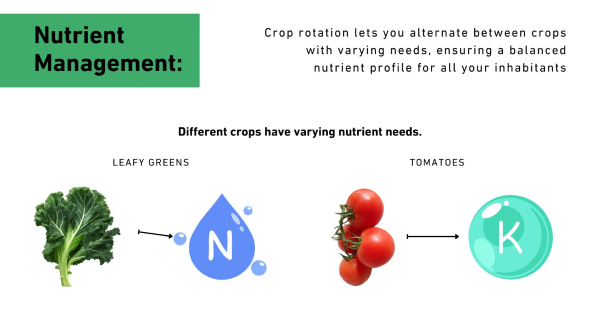
Pest and Disease Control: Rotating crops disrupts the lifecycle of pests and diseases that specialize in certain plants, making it harder for them to establish and spread.
Improved Medium Health: Even in hydroponics, a healthy microbiome is crucial. Crop rotation promotes a diverse microbial community, leading to better nutrient breakdown and improved plant health.
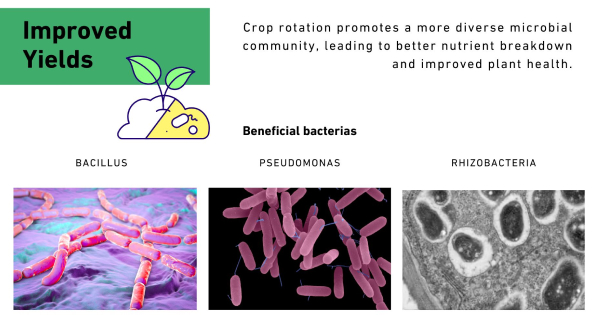
System Sustainability: Crop rotation is like preventative maintenance for your greenhouse. It helps maintain balance, reduces risks, and contributes to long-term success.
Maintaining a Clean and Healthy Hydroponic System: Disinfection and Sanitation
A critical, often overlooked, aspect of successful hydroponic crop rotation is maintaining a clean and disease-free environment. Unlike soil-based systems, hydroponics offers the advantage of complete system sanitation between crop cycles. This ability to thoroughly clean and disinfect your hydroponic system is a powerful tool in preventing disease outbreaks and maximizing yields. Before introducing a new crop in your rotation, take the time to meticulously clean all components.

This includes flushing nutrient solutions from reservoirs and pipes, scrubbing growing trays and containers, and disinfecting all surfaces that come into contact with plants or nutrient solutions. Utilize food-grade disinfectants appropriate for hydroponic systems, ensuring they are thoroughly rinsed away before replanting. This proactive approach to hygiene is essential for breaking disease cycles and preventing the carryover of pathogens from one crop to the next.
A clean system not only minimizes disease risk but also contributes to optimal plant health and nutrient uptake, laying the foundation for a successful crop rotation strategy. Coupled with regular monitoring of your system’s pH, EC, and other key parameters, a commitment to cleanliness will significantly enhance your overall production and profitability.

How to Identify the Need for Crop Rotation in Hydroponics
Pay close attention to these telltale signs:
- Stunted growth: Are your plants lagging behind? Could be nutrient deficiencies or toxicities.
- Discoloration or leaf damage: Yellowing leaves? Brown spots? Time to investigate nutrient imbalances.
- pH fluctuations: Keep a close eye on those pH levels. Consistent drift outside the optimal range? Crop rotation might be the answer.
- Pest and disease outbreaks: Visible pests? Damage to leaves or roots? Don’t wait for a full-blown infestation. Rotate those crops!
- Declining crop quality: Poor flavor? Reduced shelf life? Something’s not right. Time for a change.
- Root health issues: Root rot? Nutrient lockout? These are serious problems that crop rotation can help prevent.
- Data analysis: Track your nutrient levels, pH, and EC. Analyze the trends. Are things going south? Time to switch things up.
Using pH and EC Data to Determine Crop Rotation Needs
Commercial hydroponic growers leverage pH and EC data as crucial indicators for optimizing crop rotation strategies. Here’s how:
pH (Potential of Hydrogen):
pH measures the acidity or alkalinity of your nutrient solution. It directly impacts nutrient availability. While optimal pH ranges vary slightly by crop, most thrive between 5.5 and 6.5. Consistent pH drift despiteregular adjustments is a key signal. F
or example, if you’re consistently battling rising pH in a system growing tomatoes (which prefer a slightly acidic range), it might indicate a buildup of alkaline salts. This suggests rotating to a crop like lettuce, which prefers a slightly higher pH and can help rebalance the system. Conversely, consistently falling pH might suggest the opposite.
EC (Electrical Conductivity):
EC measures the total concentration of dissolved salts and minerals in your nutrient solution – essentially, its strength. High EC can lead to salt buildup, damaging roots and causing nutrient lockout.
A consistent increase in EC, even if you haven’t changed your fertilizer regimen, is a red flag. This signals accumulating salts. Commercial growers often respond by rotating to a crop that is less sensitive to higher EC levels or requires less fertilizer. For instance, after a heavy feeding crop like cucumbers, rotating to a lighter feeder like spinach can help lower the overall EC.
Learn more about EC sensors – LEARN HERE
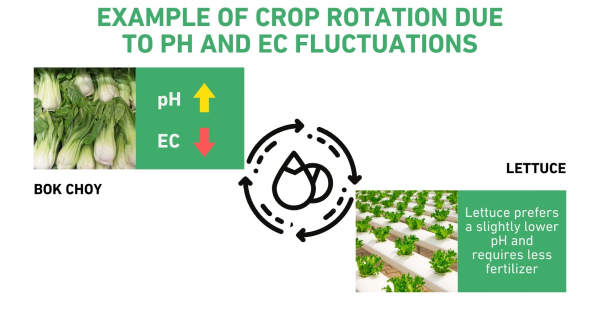
Data Analysis for Crop Rotation Decisions: Successful growers meticulously track pH and EC levels, not just as individual data points, but as part of a larger trend analysis.
- Regular Monitoring and Recording: pH and EC readings are taken daily or weekly and logged in spreadsheets or dedicated software. This consistent data collection is crucial.
- Trend Identification: The focus is on identifying trends over multiple growing cycles. Are pH levels consistently rising or falling? Is EC steadily increasing? These patterns are more informative than a single reading.
- Crop Requirement Consideration: Once trends are identified, they’re cross-referenced with the specific pH and EC requirements of potential rotation crops. This ensures the chosen crop can thrive in the current system conditions.
- Informed Decision-Making: The combination of trend analysis and crop-specific needs informs the rotation strategy. The goal is to proactively address imbalances before they negatively impact yield or quality. This data-driven approach allows commercial growers to fine-tune their rotations for optimal production.
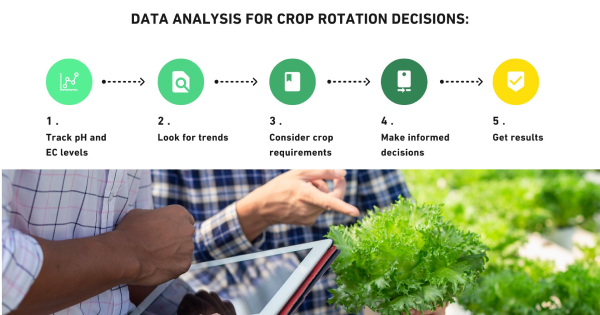
Crop Rotation Guide: Designing a Plan for Your Greenhouse
Here’s your step-by-step blueprint for success:
- Prioritize Diversity: Mix it up! Leafy greens, fruiting vegetables, herbs – the more diverse, the better.
- Consider Nutrient Requirements: Match crops to your system’s capabilities and avoid nutrient depletion.
- Balance Heavy and Light Feeders: Prevent nutrient buildup and ensure efficient utilization.
- Factor in Pest and Disease Susceptibility: Disrupt those pesky cycles and reduce the need for pesticides.
- Plan for Seasonal Variations: Optimize crop selection based on temperature and light levels.
- Monitor and Adjust: Keep a close eye on your crops and nutrient levels. Adapt as needed.
- Utilize Companion Planting: Boost crop health and productivity with strategic interplanting.
- Record Keeping: Track everything! Planting dates, varieties, nutrient levels, yields – it’s all valuable data.
Selecting the Right Crops for Your Setup
Here’s what to consider:
- Climate Control Capabilities: Can your system handle the temperature, light, and humidity needs of your chosen crops? Check HERE the full automation Kit for commercial hydroponics greenhouses
- Market Demand & Profitability: What’s hot in your region? Balance high-value specialty crops with staple vegetables.
- Suitability for Hydroponics: Choose crops with root systems that thrive in soilless environments.
- Space Constraints and Vertical Growing Potential: Maximize space utilization with vertical growing and intercropping.
- Disease & Pest Resistance: Minimize risks by selecting resistant varieties.
Top Crops for Greenhouses & Hydroponics
Leafy Greens: Lettuce, kale, spinach – fast-growing, high-yielding, and adaptable.
Herbs: Basil, mint, and others – high-value, space-efficient, and thrive with proper control.
Tomatoes & Peppers: High-value crops that can be very profitable with careful management.
Emerging Options: Microgreens, vertical farming crops – high profit margins and cater to growing demand.
Top 10 World Crop Type Leaders in Commercial Greenhouse Horticulture (Based on Proven Data)
Source: Food and Agriculture Organization of the United Nations (FAO) – http://www.fao.org/home/en/
| Rank | Crop Type | Global Greenhouse Production (tonnes) | Percentage of Total Greenhouse Production |
| 1 | Tomatoes | 18,923,185 | 33.3% |
| 2 | Cucumbers & Gherkins | 8,241,592 | 14.6% |
| 3 | Lettuce & Chicory | 5,982,371 | 10.6% |
| 4 | Sweet Peppers (Bell Peppers) | 4,210,834 | 7.4% |
| 5 | Eggplants | 3,871,529 | 6.8% |
| 6 | Strawberries | 2,910,476 | 5.1% |
| 7 | Herbs (including basil, mint, parsley) | 2,348,167 | 4.1% |
| 8 | Head Cabbage & Chinese Cabbage | 1,823,749 | 3.2% |
| 9 | Melons (including watermelons, cantaloupes) | 1,582,310 | 2.8% |
| 10 | Cut Flowers (including roses, lilies, chrysanthemums) | 1,347,291 | 2.4% |
Data is based on the latest available information from the FAO (2020).
Conclusion: Crop Rotation – Your Key to Greenhouse Domination
Crop rotation is your secret weapon for maximizing yields, minimizing risks, and creating a thriving ecosystem in your controlled environment. By implementing the strategies we’ve discussed, you’ll be well on your way to crushing those profit goals and becoming a CEA rockstar.
Now go forth and grow!
